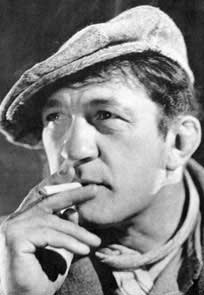"Do not look at the faces in the illustrated papers. Look at the faces in the street."
--G.K. Chesterton
Just before his death in
2007, 100-year-old Charles Lane
had begun work on a documentary called “You Know the Face” about his life and
work as a character actor.
Unfortunately, the work was never completed; nevertheless, it would have
been aptly named, because from 1931 until 2006, Charles Lane appeared in nearly 400 films
and television shows, making him one of the most familiar faces in the
backdrop of Hollywood
productions for whole generations of film-goers.
 |
| Charles Lane, looking his usual surly self |
Though seldom appearing for long in
any feature, Lane filled roles of vastly-varying professions, from
reporters to rent collectors, from psychiatrists to census takers, from
secretaries to superintendents, and yet he played—almost exclusively—the same
sort of character: a sharp-nosed, practical, antagonistic, business-first
fellow in spectacles. Lane himself
recognized the queer continuity of all these roles: “Having had so many small
parts,” he once said, “there was a character I played that showed up all the
time and people did get to know him, like an old friend.”
 |
| Walter Brennan |
That notion of an “old friend”
beautifully sums up the special, undervalued role character actors play in
establishing a film's quality and atmosphere—the way they help make a
piece of Hollywood artwork “great” or “classic.” Of course, when we speak of “Hollywood actors and actresses,” it’s tempting to think
exclusively of the stars, like Clark Gable or Audrey Hepburn. But while the
stars may be the center of everyone’s attention, the truth is that they never
could have made those fantastic splashes of talent and popularity without the
steady acting support of the forgettable but reliable “character actors:” actors who were type-cast or continually filled minor roles that colored in the
background. Recurring in dozens of films, often playing the same
sort of character, as Lane did, or at least playing different roles with a soon-familiar face, character actors made films more
complete. They acted like pieces of the set or colors in the backdrop on a stage:
even though they were never the center of attention, by their excellence of
serving their purpose they made a movie more vivid, more realistic—in a word,
more like life.
 | ||
| Marjorie Main and Percy Kilbride as Ma and Pa Kettle |
 |
| The inimitable Edna May Oliver |
The reason for this was simply because
they played people you meet in “real life”: mere “fellows-on-the-street,”
non-glamorous side figures, non-heroes—the sort of person you find in the
doctor’s waiting room, behind the cash register, on the train. They were there
precisely to flesh out the world surrounding the central characters, and
consequently they often packed a punch, so to speak, into the tiny
tidbit-of-a-role they had. Good
character actors are the spice and color of a film; they are the sort of people
of which the world is full—the “common man” incarnate in a particular way, a
personality in a crowd. After all, let’s
face it—perhaps it’s true that everyone wants to be Cary Grant (“Even Cary
Grant,” as the man himself once said), but the stereotypical hero of a story can
often be less colorful than the life-like characters that surround him: the
dying old soldier, the hot-tempered Italian grandmother, the dottering country
minister, the local drunk, the obsequious villain’s side-kick, the drawling
farm boy, the loony old professor, the brusque British police inspector, the
wise-cracking taxi driver.
 |
| Victor McLaglen, a Ford regular |
These people aren’t the
meat-and-potatoes of a film, but they certainly are the relish; and one
director who knew this full-well was the legendary Irish-American John Ford. Ford had a peculiar talent for gathering around him a group of actors and
actresses he would reuse again and again as steady characters that seem to link
together all his cinema creations into a cohesive whole. Take for instance, Ford’s cavalry
films—She Wore A Yellow Ribbon, Fort Apache, and Rio Grande—each of the movies has an almost identical cast, with a
few notable exceptions, and some of the characters even have the same names in
the different movies. Ford, a compositional genius, doubtless knew
that standardizing his background cast could unify and tighten the impression
his films were to make on his audience. When you begin watching his movies, you
start to grow accustomed to seeing the same faces in their old place; it’s an
evocative sensation, giving the impression that members of a family are gathering
around to tell a tale together. There is a
peculiar sort of comfort and delight in seeing those familiar figures again and
again, in varying roles but always solidly delivering performances that
heighten the atmospheric tint of the whole film.
 |
| Peter Lorre |
 |
| Guy Kibbee |
So, here’s
to the character actors, the fellows in the background, the faces
in the street. They spice up the stories we love and make them that more
believable, because they are tastes of real life--equally full of
interesting and unusual people who don’t fit the stereotypes of hero or
heroine. They remind us of people we’ve met and known, even in passing, and so
they have become to us—as Lane put it—like old friends.
No comments:
Post a Comment
Please leave a comment!